seats LINCOLN MKT 2019 Owners Manual
[x] Cancel search | Manufacturer: LINCOLN, Model Year: 2019, Model line: MKT, Model: LINCOLN MKT 2019Pages: 575, PDF Size: 4.66 MB
Page 4 of 575
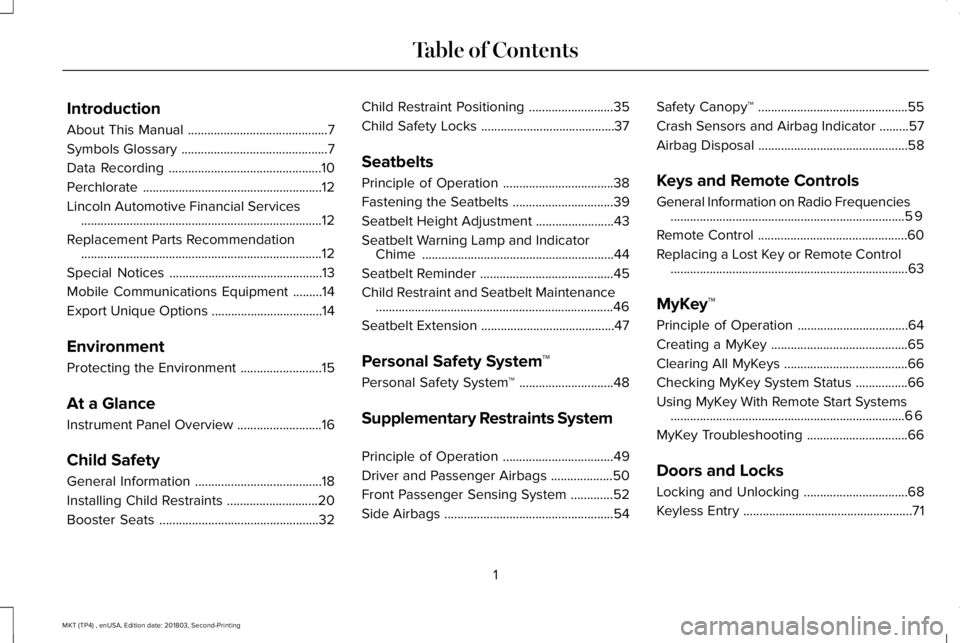
Introduction
About This Manual...........................................7
Symbols Glossary.............................................7
Data Recording...............................................10
Perchlorate.......................................................12
Lincoln Automotive Financial Services..........................................................................12
Replacement Parts Recommendation..........................................................................12
Special Notices...............................................13
Mobile Communications Equipment.........14
Export Unique Options..................................14
Environment
Protecting the Environment.........................15
At a Glance
Instrument Panel Overview..........................16
Child Safety
General Information.......................................18
Installing Child Restraints............................20
Booster Seats.................................................32
Child Restraint Positioning..........................35
Child Safety Locks.........................................37
Seatbelts
Principle of Operation..................................38
Fastening the Seatbelts...............................39
Seatbelt Height Adjustment........................43
Seatbelt Warning Lamp and IndicatorChime...........................................................44
Seatbelt Reminder.........................................45
Child Restraint and Seatbelt Maintenance.........................................................................46
Seatbelt Extension.........................................47
Personal Safety System™
Personal Safety System™.............................48
Supplementary Restraints System
Principle of Operation..................................49
Driver and Passenger Airbags...................50
Front Passenger Sensing System.............52
Side Airbags....................................................54
Safety Canopy™..............................................55
Crash Sensors and Airbag Indicator.........57
Airbag Disposal..............................................58
Keys and Remote Controls
General Information on Radio Frequencies........................................................................59
Remote Control..............................................60
Replacing a Lost Key or Remote Control.........................................................................63
MyKey™
Principle of Operation..................................64
Creating a MyKey..........................................65
Clearing All MyKeys......................................66
Checking MyKey System Status................66
Using MyKey With Remote Start Systems........................................................................66
MyKey Troubleshooting...............................66
Doors and Locks
Locking and Unlocking................................68
Keyless Entry....................................................71
1
MKT (TP4) , enUSA, Edition date: 201803, Second-Printing
Table of Contents
Page 5 of 575
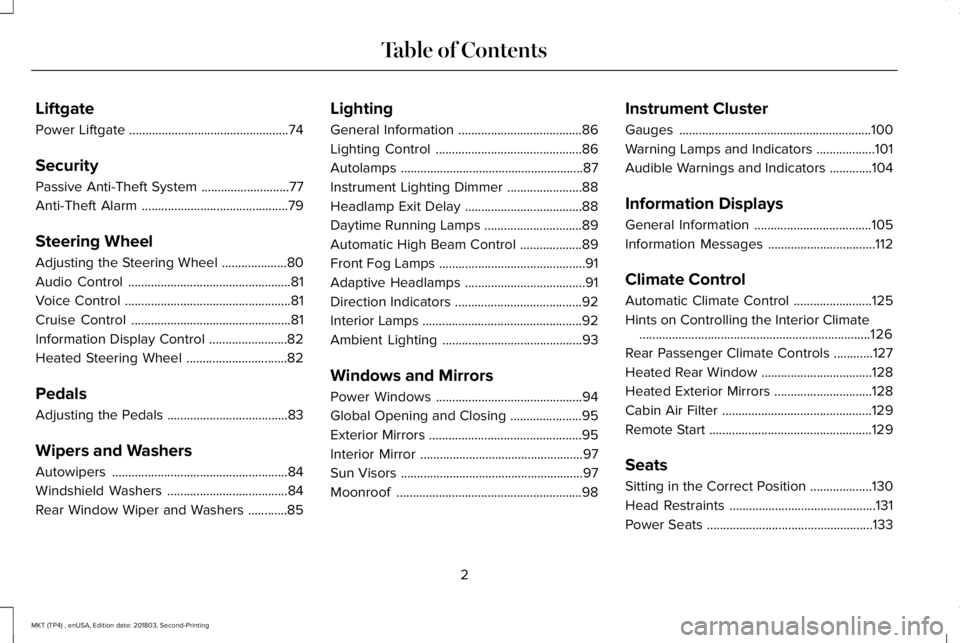
Liftgate
Power Liftgate.................................................74
Security
Passive Anti-Theft System...........................77
Anti-Theft Alarm.............................................79
Steering Wheel
Adjusting the Steering Wheel....................80
Audio Control..................................................81
Voice Control...................................................81
Cruise Control.................................................81
Information Display Control........................82
Heated Steering Wheel...............................82
Pedals
Adjusting the Pedals.....................................83
Wipers and Washers
Autowipers......................................................84
Windshield Washers.....................................84
Rear Window Wiper and Washers............85
Lighting
General Information......................................86
Lighting Control.............................................86
Autolamps........................................................87
Instrument Lighting Dimmer.......................88
Headlamp Exit Delay....................................88
Daytime Running Lamps..............................89
Automatic High Beam Control...................89
Front Fog Lamps.............................................91
Adaptive Headlamps.....................................91
Direction Indicators.......................................92
Interior Lamps.................................................92
Ambient Lighting...........................................93
Windows and Mirrors
Power Windows.............................................94
Global Opening and Closing......................95
Exterior Mirrors...............................................95
Interior Mirror..................................................97
Sun Visors........................................................97
Moonroof.........................................................98
Instrument Cluster
Gauges...........................................................100
Warning Lamps and Indicators..................101
Audible Warnings and Indicators.............104
Information Displays
General Information....................................105
Information Messages.................................112
Climate Control
Automatic Climate Control........................125
Hints on Controlling the Interior Climate.......................................................................126
Rear Passenger Climate Controls............127
Heated Rear Window..................................128
Heated Exterior Mirrors..............................128
Cabin Air Filter..............................................129
Remote Start..................................................129
Seats
Sitting in the Correct Position...................130
Head Restraints.............................................131
Power Seats...................................................133
2
MKT (TP4) , enUSA, Edition date: 201803, Second-Printing
Table of Contents
Page 6 of 575
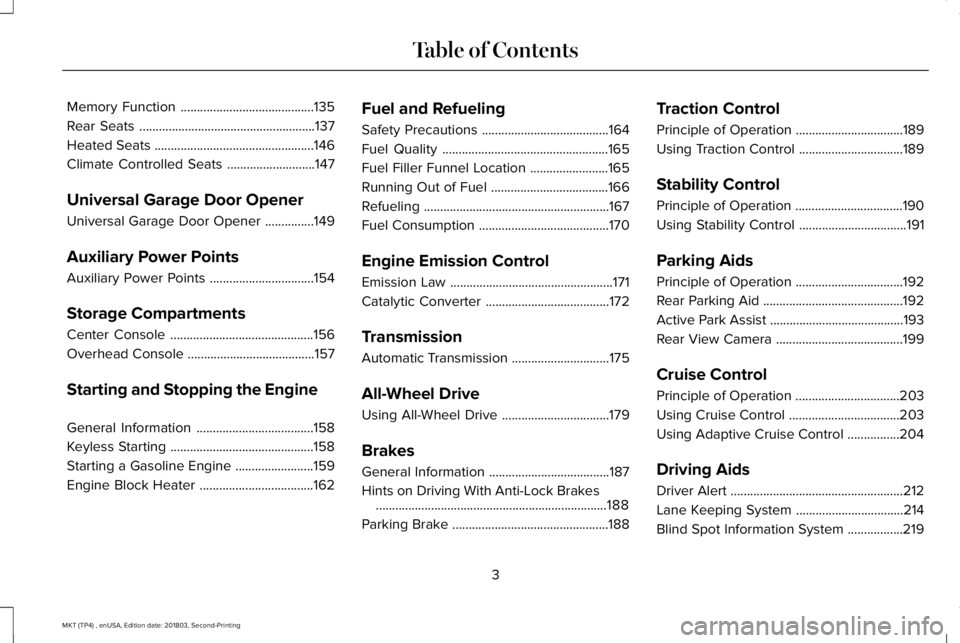
Memory Function.........................................135
Rear Seats......................................................137
Heated Seats.................................................146
Climate Controlled Seats...........................147
Universal Garage Door Opener
Universal Garage Door Opener...............149
Auxiliary Power Points
Auxiliary Power Points................................154
Storage Compartments
Center Console............................................156
Overhead Console.......................................157
Starting and Stopping the Engine
General Information....................................158
Keyless Starting............................................158
Starting a Gasoline Engine........................159
Engine Block Heater...................................162
Fuel and Refueling
Safety Precautions.......................................164
Fuel Quality...................................................165
Fuel Filler Funnel Location........................165
Running Out of Fuel....................................166
Refueling.........................................................167
Fuel Consumption........................................170
Engine Emission Control
Emission Law..................................................171
Catalytic Converter......................................172
Transmission
Automatic Transmission..............................175
All-Wheel Drive
Using All-Wheel Drive.................................179
Brakes
General Information.....................................187
Hints on Driving With Anti-Lock Brakes.......................................................................188
Parking Brake................................................188
Traction Control
Principle of Operation.................................189
Using Traction Control................................189
Stability Control
Principle of Operation.................................190
Using Stability Control.................................191
Parking Aids
Principle of Operation.................................192
Rear Parking Aid...........................................192
Active Park Assist.........................................193
Rear View Camera.......................................199
Cruise Control
Principle of Operation................................203
Using Cruise Control..................................203
Using Adaptive Cruise Control................204
Driving Aids
Driver Alert.....................................................212
Lane Keeping System.................................214
Blind Spot Information System.................219
3
MKT (TP4) , enUSA, Edition date: 201803, Second-Printing
Table of Contents
Page 8 of 575
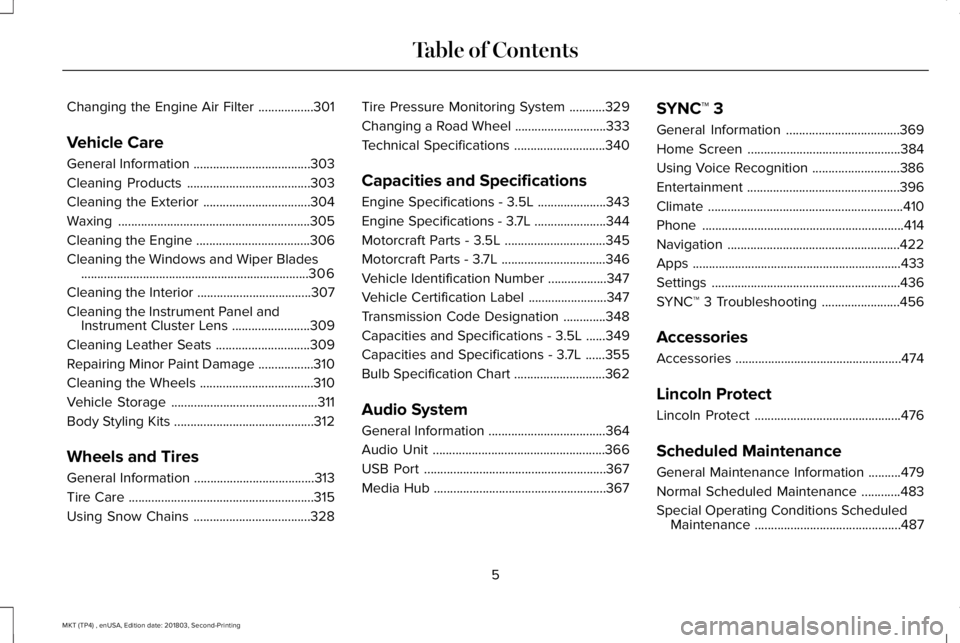
Changing the Engine Air Filter.................301
Vehicle Care
General Information....................................303
Cleaning Products......................................303
Cleaning the Exterior.................................304
Waxing...........................................................305
Cleaning the Engine...................................306
Cleaning the Windows and Wiper Blades......................................................................306
Cleaning the Interior...................................307
Cleaning the Instrument Panel andInstrument Cluster Lens........................309
Cleaning Leather Seats.............................309
Repairing Minor Paint Damage.................310
Cleaning the Wheels...................................310
Vehicle Storage.............................................311
Body Styling Kits...........................................312
Wheels and Tires
General Information.....................................313
Tire Care.........................................................315
Using Snow Chains....................................328
Tire Pressure Monitoring System...........329
Changing a Road Wheel............................333
Technical Specifications............................340
Capacities and Specifications
Engine Specifications - 3.5L.....................343
Engine Specifications - 3.7L......................344
Motorcraft Parts - 3.5L...............................345
Motorcraft Parts - 3.7L................................346
Vehicle Identification Number..................347
Vehicle Certification Label........................347
Transmission Code Designation.............348
Capacities and Specifications - 3.5L......349
Capacities and Specifications - 3.7L......355
Bulb Specification Chart............................362
Audio System
General Information....................................364
Audio Unit.....................................................366
USB Port........................................................367
Media Hub.....................................................367
SYNC™ 3
General Information...................................369
Home Screen...............................................384
Using Voice Recognition...........................386
Entertainment...............................................396
Climate............................................................410
Phone..............................................................414
Navigation.....................................................422
Apps................................................................433
Settings..........................................................436
SYNC™ 3 Troubleshooting........................456
Accessories
Accessories...................................................474
Lincoln Protect
Lincoln Protect.............................................476
Scheduled Maintenance
General Maintenance Information..........479
Normal Scheduled Maintenance............483
Special Operating Conditions ScheduledMaintenance.............................................487
5
MKT (TP4) , enUSA, Edition date: 201803, Second-Printing
Table of Contents
Page 23 of 575
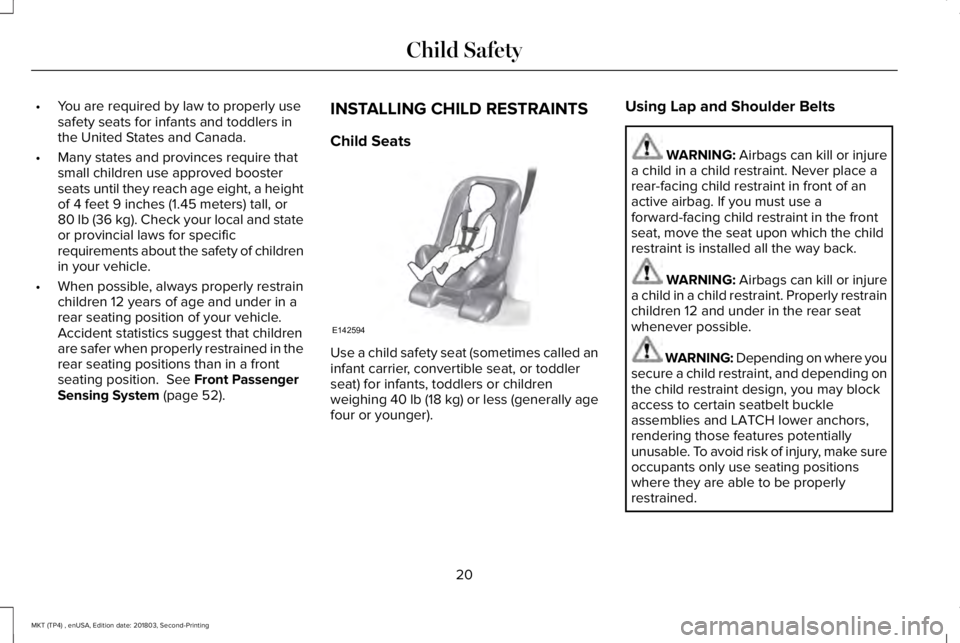
•You are required by law to properly usesafety seats for infants and toddlers inthe United States and Canada.
•Many states and provinces require thatsmall children use approved boosterseats until they reach age eight, a heightof 4 feet 9 inches (1.45 meters) tall, or80 lb (36 kg). Check your local and stateor provincial laws for specificrequirements about the safety of childrenin your vehicle.
•When possible, always properly restrainchildren 12 years of age and under in arear seating position of your vehicle.Accident statistics suggest that childrenare safer when properly restrained in therear seating positions than in a frontseating position. See Front PassengerSensing System (page 52).
INSTALLING CHILD RESTRAINTS
Child Seats
Use a child safety seat (sometimes called aninfant carrier, convertible seat, or toddlerseat) for infants, toddlers or childrenweighing 40 lb (18 kg) or less (generally agefour or younger).
Using Lap and Shoulder Belts
WARNING: Airbags can kill or injurea child in a child restraint. Never place arear-facing child restraint in front of anactive airbag. If you must use aforward-facing child restraint in the frontseat, move the seat upon which the childrestraint is installed all the way back.
WARNING: Airbags can kill or injurea child in a child restraint. Properly restrainchildren 12 and under in the rear seatwhenever possible.
WARNING: Depending on where yousecure a child restraint, and depending onthe child restraint design, you may blockaccess to certain seatbelt buckleassemblies and LATCH lower anchors,rendering those features potentiallyunusable. To avoid risk of injury, make sureoccupants only use seating positionswhere they are able to be properlyrestrained.
20
MKT (TP4) , enUSA, Edition date: 201803, Second-Printing
Child SafetyE142594
Page 25 of 575
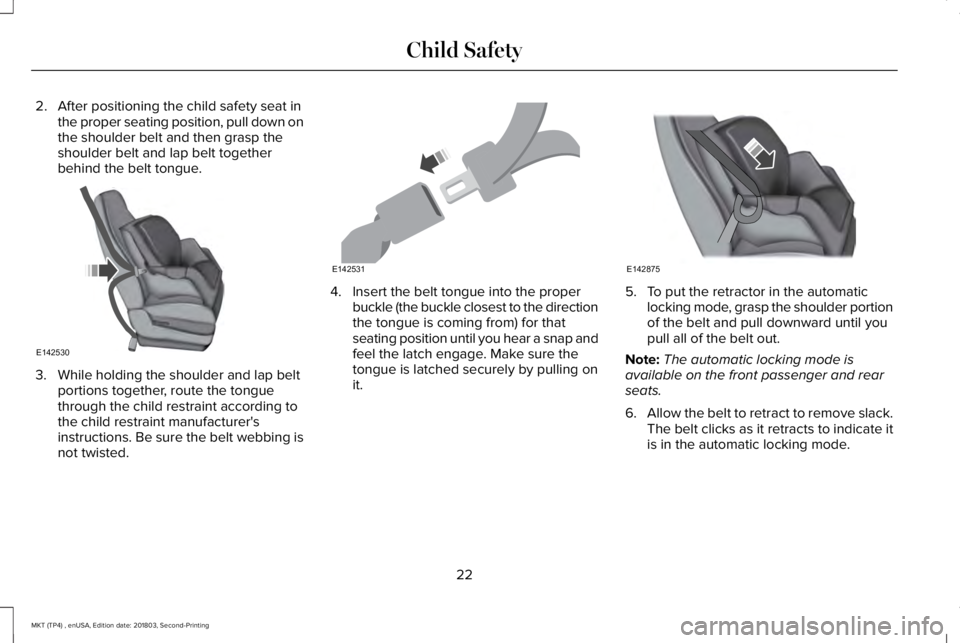
2. After positioning the child safety seat inthe proper seating position, pull down onthe shoulder belt and then grasp theshoulder belt and lap belt togetherbehind the belt tongue.
3. While holding the shoulder and lap beltportions together, route the tonguethrough the child restraint according tothe child restraint manufacturer'sinstructions. Be sure the belt webbing isnot twisted.
4. Insert the belt tongue into the properbuckle (the buckle closest to the directionthe tongue is coming from) for thatseating position until you hear a snap andfeel the latch engage. Make sure thetongue is latched securely by pulling onit.
5. To put the retractor in the automaticlocking mode, grasp the shoulder portionof the belt and pull downward until youpull all of the belt out.
Note:The automatic locking mode isavailable on the front passenger and rearseats.
6.Allow the belt to retract to remove slack.The belt clicks as it retracts to indicate itis in the automatic locking mode.
22
MKT (TP4) , enUSA, Edition date: 201803, Second-Printing
Child SafetyE142530 E142531 E142875
Page 28 of 575
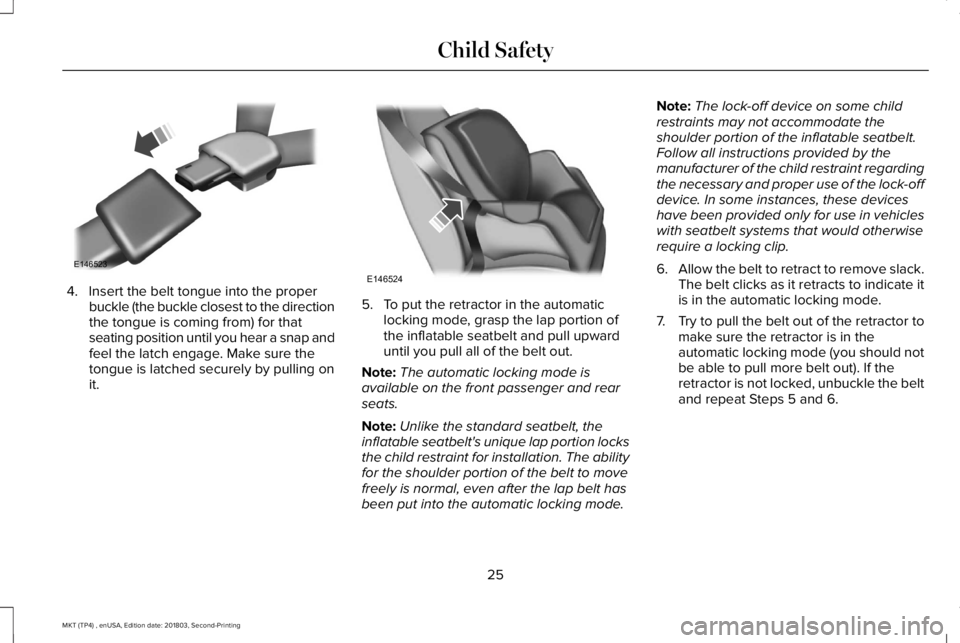
4. Insert the belt tongue into the properbuckle (the buckle closest to the directionthe tongue is coming from) for thatseating position until you hear a snap andfeel the latch engage. Make sure thetongue is latched securely by pulling onit.
5. To put the retractor in the automaticlocking mode, grasp the lap portion ofthe inflatable seatbelt and pull upwarduntil you pull all of the belt out.
Note:The automatic locking mode isavailable on the front passenger and rearseats.
Note:Unlike the standard seatbelt, theinflatable seatbelt's unique lap portion locksthe child restraint for installation. The abilityfor the shoulder portion of the belt to movefreely is normal, even after the lap belt hasbeen put into the automatic locking mode.
Note:The lock-off device on some childrestraints may not accommodate theshoulder portion of the inflatable seatbelt.Follow all instructions provided by themanufacturer of the child restraint regardingthe necessary and proper use of the lock-offdevice. In some instances, these deviceshave been provided only for use in vehicleswith seatbelt systems that would otherwiserequire a locking clip.
6.Allow the belt to retract to remove slack.The belt clicks as it retracts to indicate itis in the automatic locking mode.
7.Try to pull the belt out of the retractor tomake sure the retractor is in theautomatic locking mode (you should notbe able to pull more belt out). If theretractor is not locked, unbuckle the beltand repeat Steps 5 and 6.
25
MKT (TP4) , enUSA, Edition date: 201803, Second-Printing
Child SafetyE146523 E146524
Page 30 of 575
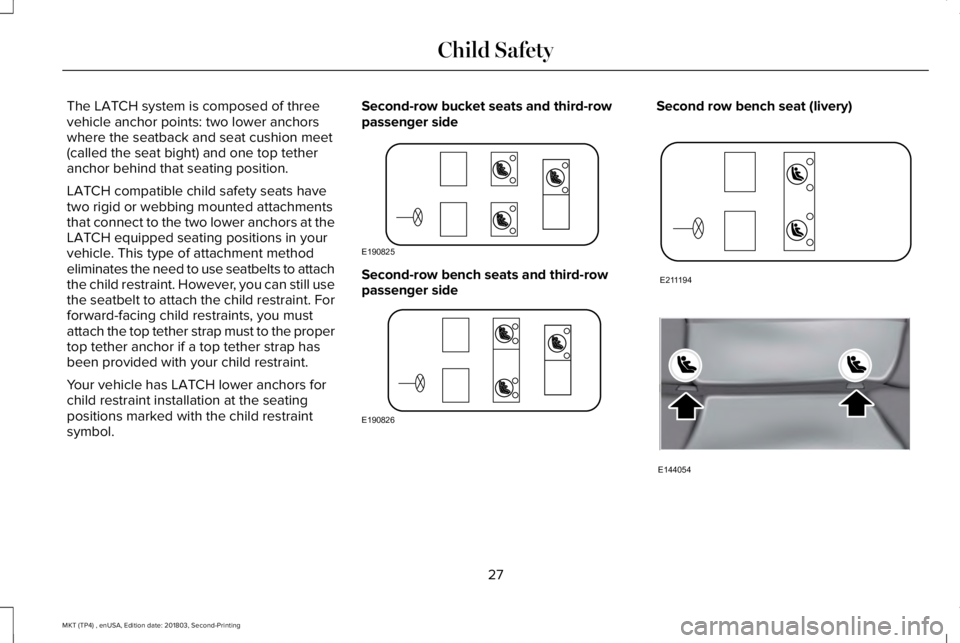
The LATCH system is composed of threevehicle anchor points: two lower anchorswhere the seatback and seat cushion meet(called the seat bight) and one top tetheranchor behind that seating position.
LATCH compatible child safety seats havetwo rigid or webbing mounted attachmentsthat connect to the two lower anchors at theLATCH equipped seating positions in yourvehicle. This type of attachment methodeliminates the need to use seatbelts to attachthe child restraint. However, you can still usethe seatbelt to attach the child restraint. Forforward-facing child restraints, you mustattach the top tether strap must to the propertop tether anchor if a top tether strap hasbeen provided with your child restraint.
Your vehicle has LATCH lower anchors forchild restraint installation at the seatingpositions marked with the child restraintsymbol.
Second-row bucket seats and third-rowpassenger side
Second-row bench seats and third-rowpassenger side
Second row bench seat (livery)
27
MKT (TP4) , enUSA, Edition date: 201803, Second-Printing
Child SafetyE190825 E190826 E211194 E144054
Page 31 of 575
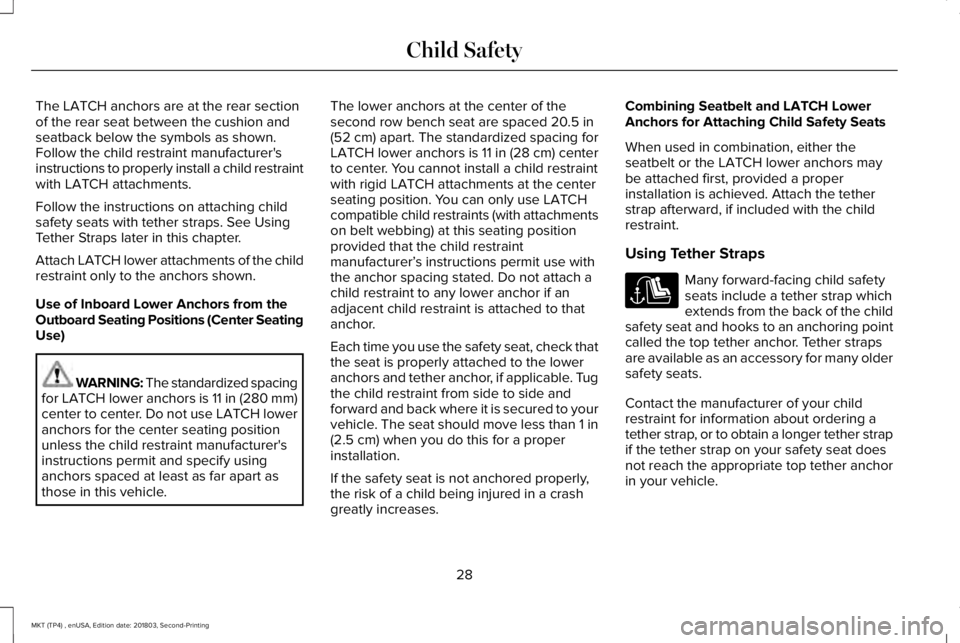
The LATCH anchors are at the rear sectionof the rear seat between the cushion andseatback below the symbols as shown.Follow the child restraint manufacturer'sinstructions to properly install a child restraintwith LATCH attachments.
Follow the instructions on attaching childsafety seats with tether straps. See UsingTether Straps later in this chapter.
Attach LATCH lower attachments of the childrestraint only to the anchors shown.
Use of Inboard Lower Anchors from theOutboard Seating Positions (Center SeatingUse)
WARNING: The standardized spacingfor LATCH lower anchors is 11 in (280 mm)center to center. Do not use LATCH loweranchors for the center seating positionunless the child restraint manufacturer'sinstructions permit and specify usinganchors spaced at least as far apart asthose in this vehicle.
The lower anchors at the center of thesecond row bench seat are spaced 20.5 in(52 cm) apart. The standardized spacing forLATCH lower anchors is 11 in (28 cm) centerto center. You cannot install a child restraintwith rigid LATCH attachments at the centerseating position. You can only use LATCHcompatible child restraints (with attachmentson belt webbing) at this seating positionprovided that the child restraintmanufacturer’s instructions permit use withthe anchor spacing stated. Do not attach achild restraint to any lower anchor if anadjacent child restraint is attached to thatanchor.
Each time you use the safety seat, check thatthe seat is properly attached to the loweranchors and tether anchor, if applicable. Tugthe child restraint from side to side andforward and back where it is secured to yourvehicle. The seat should move less than 1 in(2.5 cm) when you do this for a properinstallation.
If the safety seat is not anchored properly,the risk of a child being injured in a crashgreatly increases.
Combining Seatbelt and LATCH LowerAnchors for Attaching Child Safety Seats
When used in combination, either theseatbelt or the LATCH lower anchors maybe attached first, provided a properinstallation is achieved. Attach the tetherstrap afterward, if included with the childrestraint.
Using Tether Straps
Many forward-facing child safetyseats include a tether strap whichextends from the back of the childsafety seat and hooks to an anchoring pointcalled the top tether anchor. Tether strapsare available as an accessory for many oldersafety seats.
Contact the manufacturer of your childrestraint for information about ordering atether strap, or to obtain a longer tether strapif the tether strap on your safety seat doesnot reach the appropriate top tether anchorin your vehicle.
28
MKT (TP4) , enUSA, Edition date: 201803, Second-Printing
Child Safety
Page 32 of 575
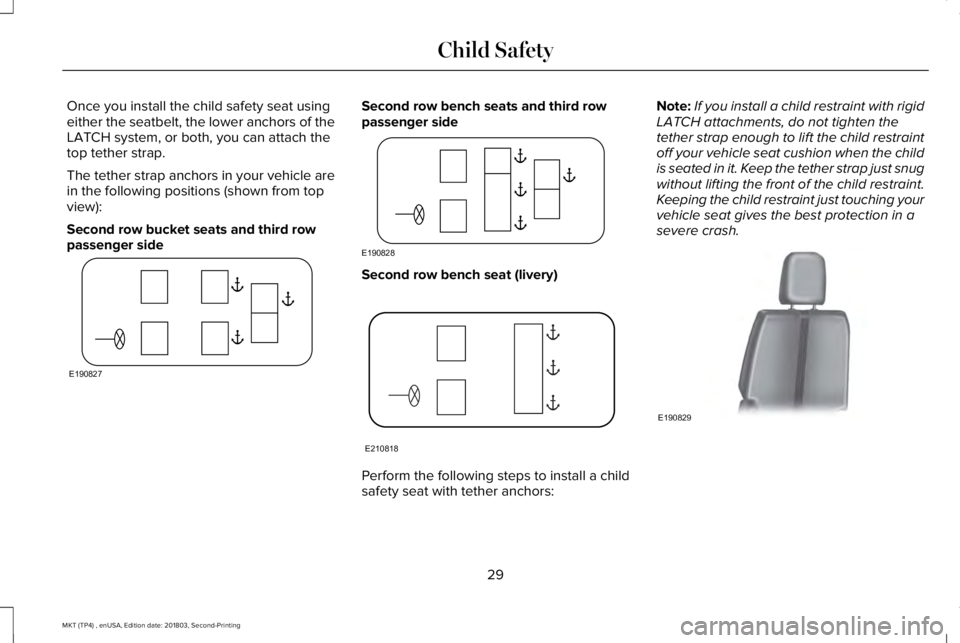
Once you install the child safety seat usingeither the seatbelt, the lower anchors of theLATCH system, or both, you can attach thetop tether strap.
The tether strap anchors in your vehicle arein the following positions (shown from topview):
Second row bucket seats and third rowpassenger side
Second row bench seats and third rowpassenger side
Second row bench seat (livery)
Perform the following steps to install a childsafety seat with tether anchors:
Note:If you install a child restraint with rigidLATCH attachments, do not tighten thetether strap enough to lift the child restraintoff your vehicle seat cushion when the childis seated in it. Keep the tether strap just snugwithout lifting the front of the child restraint.Keeping the child restraint just touching yourvehicle seat gives the best protection in asevere crash.
29
MKT (TP4) , enUSA, Edition date: 201803, Second-Printing
Child SafetyE190827 E190828 E210818 E190829